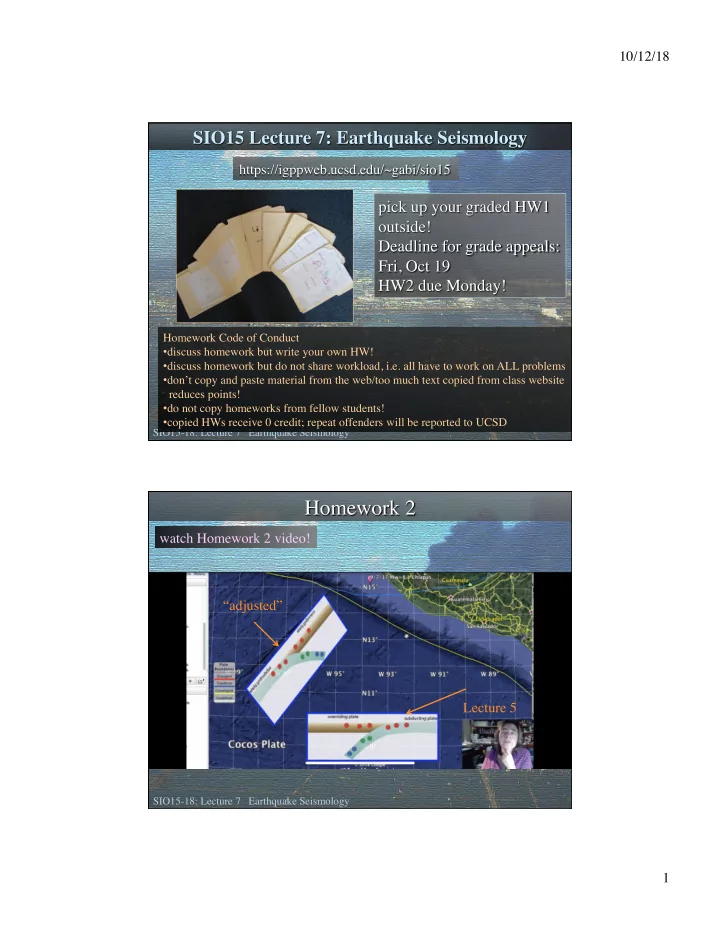

10/12/18 Homework Code of Conduct • discuss homework but write your own HW! • discuss homework but do not share workload, i.e. all have to work on ALL problems • don’t copy and paste material from the web/too much text copied from class website reduces points! • do not copy homeworks from fellow students! • copied HWs receive 0 credit; repeat offenders will be reported to UCSD SIO15-18: Lecture 7 Earthquake Seismology watch Homework 2 video! “adjusted” Lecture 5 SIO15-18: Lecture 7 Earthquake Seismology 1
10/12/18 source: wikipedia; SD-UT SIO15-18: Lecture 7 Earthquake Seismology source: wikipedia; SD-UT SIO15-18: Lecture 7 Earthquake Seismology 2
10/12/18 also made landfall in FL SIO15-18: Lecture 7 Earthquake Seismology source: wikipedia; NOAA POPQUIZ #2 YOUR FULL NAME AND STUDENT ID# no credit if one is missing Compared to long faults, large earthquakes are • less likely • more likely • equally likely on shorter faults? Code of Conduct: you may ask your neighbor you may consult your notes, book, online you may NOT write and/or submit your friend’s popquiz SIO15-18: Lecture 7 Earthquake Seismology 3
10/12/18 POPQUIZ #3 YOUR NAME AND STUDENT ID# Which of the 3 types of earthquakes USUALLY does not trigger a tsunami? Code of Conduct: you may ask your neighbor you may consult your notes, book, online you may NOT write and/or submit your friend’s popquiz SIO15-18: Lecture 7 Earthquake Seismology P and S Waves are body waves Image: S. Marshak “Earth, Portrait of a Planet” SIO15-18: Lecture 7 Earthquake Seismology 4
10/12/18 R 1. P first, typically smallest signal 2. S, typically larger (felt by humans) 3. Love 4. Rayleigh, longest/largest wavetrain, most damaging short video 7 on : p wave used in early warning systems seismic waves warning time: up to 1 minute how to locate an earthquake SIO15-18: Lecture 7 Earthquake Seismology R short video 7 on : seismic waves how to locate an earthquake SIO15-18: Lecture 7 Earthquake Seismology 5
10/12/18 SIO15-18: Lecture 7 Earthquake Seismology from Lecture 2 relaxed relaxed cause force <-> stress loaded loaded response deformation <-> strain Fg = k x x Epot = 1/2 k x x 2 strain is a result of stress Loading a Spring Loading an EQ Fault SIO15-18: Lecture 7 Earthquake Seismology 6
10/12/18 Fig. 5.18 there is already a fault why don’t blocks move all the time? Friction Stress no EQ Stress Friction EQ! asperities: protrusions that increase friction along a fault EQ: when stresses high enough to overcome friction fault breccia/fault gouge: broken-off, ground up asperities SIO15-18: Lecture 7 Earthquake Seismology fault locked very little creep fault locked very little creep 1. stress builds up; asperities; no motion 2. stress overcomes friction -> EQ + aftershocks 3. slip along fault; stress drop Fig. 5.19 • start from 1) SIO15-18: Lecture 7 Earthquake Seismology 7
10/12/18 • some history of local seismicity in Seattle/Tacoma area • no recorded history of megathrust EQ • 1700 orphan tsunami in Japan has no corresponding local EQ -> M W =9.0 in Cascadia • recurrence time ~ 300 years • complex aseismic slip and episodic tremors (GPS and seismometers) Fig. 5.21 SIO15-18: Lecture 7 Earthquake Seismology Fig. 5.15 � EQs not regular � recurrence time has a certain probability < 100% source: Abbott “Natural Disasters” SIO15-18: Lecture 7 Earthquake Seismology 8
10/12/18 Fig. 5.16 � recurrence time varies along same fault source: Abbott “Natural Disasters” Probability of EQ before 2032 • 30% chance for a mag 7 quake before 2032, for most places along SAF prognosis for before 2004 • 90% chance for a mag 6 at Parkfield seismic gap/recurrence SIO15-18: Lecture 7 Earthquake Seismology Fig. 5.17 use seismic gap method � EQ recurrence time � Parkfield EQs remarkably regular in > 100 years � next predicted: 1993 28 September 2004, 10:15 PSDT * #7 late or #8 early??? SIO15-18: Lecture 7 Earthquake Seismology 9
10/12/18 Fig. 5.17 - Mw= 6.5 December 22, 2003 San Simeon EQ increased stress at Parkfield - made #8 more likely??? - but why did #7 not happen? - EQs can trigger/influence other EQs on nearby faults (1992 Landers/Big Bear) - very large EQs may trigger volcanism far away (Rayleigh waves!) (2002 Denali EQ/Yellowstone; 2004 Sumatra/Alaska volcanoes) SIO15-18: Lecture 7 Earthquake Seismology Fig. 6.43 InSAR: Interferometric Synthetic Aperture Radar • overlay satellite altimetry map before and after EQ • interferogram -> fringes show amount of slip along fault Sep 17, 1999 Izmit, Turkey Earthquake SIO15-18: Lecture 7 Earthquake Seismology Image: NASA/JPL; wikipedia 10
10/12/18 • example: southern SAF • last major EQ: 250 years ago, while north and middle SAF ruptured 1906 and 1857 • typical co-seismic slip for big EQs: 7-10m relaxed loaded • use stack of INSAR images to get strain rate • extrapolate to 250yrs SIO15-18: Lecture 7 Earthquake Seismology Fig. 6.44 site amplification takes into account local geology probability of strong shaking takes into account local geology, tectonics, seismicity Fig. 6.45 SIO15-18: Lecture 7 Earthquake Seismology 11
Recommend
More recommend